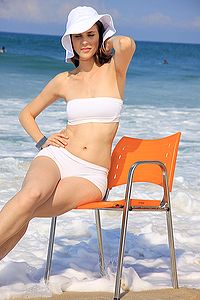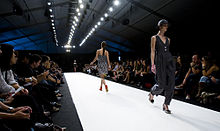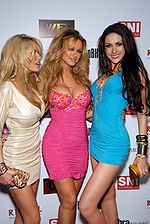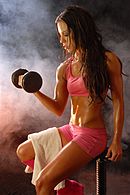- Model (person)
-
For other uses, see Model (disambiguation).
A model (from Middle French modèle),[1] sometimes called a mannequin, is a person who is employed to display, advertise and promote commercial products (notably fashion clothing) or to serve as a subject of works of art.Modelling (doubled "l" in British spelling, single "l" in American spelling) is distinguished from other types of public performance, such as an acting, dancing or mime artist, although the boundary is not well defined. Appearing in a movie or a play is not considered modelling.
Types of modelling include fashion, glamour, fitness, bikini, fine art, and body-part models. Models are features in a variety of media formats including books, magazines, movies, newspapers, and TV. Models sometimes are featured in movies (Looker, Tattoo), reality television shows (America's Next Top Model, The Janice Dickinson Modeling Agency), or music videos ("Freedom! '90", "Wicked Game", "Daughters").
Contents
Modeling agency
A modeling agency is a company that represents a group of models which they call their model board. Model bookers (also called "bookers" or "agents") manage a model's career. Agents help a model find jobs, book jobs, give advice, and email or give copy books and comp cards to various clients they work with (a comp card is a selection of pictures printed on a card, a copy book is a scanned version of a models portfolio). Agents may send models to various clients and schedule modelling interviews (also called go and see or castings).[citation needed]
A model could work without an agent but it is highly recommended for fashion/runway models. [2]
Fashion models
History
The first person described as a fashion model is Parisian shopgirl, Marie Vernet Worth. She was a house model in 1852, to her fashion designer husband, Charles Frederick Worth.[3][4] Even after fashion photography became important, fashion models generally remained fairly anonymous and relatively poorly paid until the late 1950s, though often marrying well. The first model widely considered to have paved the way for what would become the supermodel was Lisa Fonssagrives, from the 1930s onwards, in America.[5] The relationship between her image on over 200 Vogue covers and her name recognition led to the importance of Vogue in shaping future supermodels. Her image appeared on the cover of fashion magazines during the 1930s, 1940s and 1950s from Town & Country, Life and Vogue to the original Vanity Fair. Dorian Leigh was also very well-known after Word War II. The rise of model as consistent media personalities perhaps began in the Swinging Sixties with figures like Jean Shrimpton, Twiggy, and Penelope Tree, and has continued ever since.
To model clothing for all people, all types of model shapes and sizes are required. The job ranking for modern fashion models are: print (part time), print modelling (full time), runway modelling, and supermodel.
Runway modelling
Runway models showcase clothes from fashion designers, fashion media, and consumers. They are also called "live models" and are self employed. Runway models work in different locations, constantly traveling between those cities where fashion is well known - London, Milan, New York City, and Paris.
The demands for runway models include certain height and weight requirements. During runway shows, models have to constantly change clothes and makeup. The models turn and stand to demonstrate the garment's key features. Models also go to interviews (called "go and sees") and must keep a portfolio of their work. They go to modelling interviews to find more work. The more experience a model has, the more likely she is to be hired for a fashion show. A runway model can work in other areas, such as department store fashion shows, creating product lines, acting etc.[6]:191-192
The British Association of Model Agents (AMA) says that female models should be around 36-24-36 in (91-61-91 cm) and at least5 ft 9 in (1.75 m) tall.[7] The average model is slender and in shape. Those who do not meet the weight requirement often try for becoming a Plus-size model <[8]
The preferred dimensions for a male model are a height of 5 ft 11 in (180 cm) to 6 ft 2 in (188 cm), a waist of 30–35 in (76.20–88.90 cm) and a chest measurement of 36–40 in (91.44–101.60 cm).[7] Male runway models have been noted as being skinny and well toned.[9]
Male and female models must also possess clear skin, healthy hair, and attractive facial features.
The former requirement measurements for models used to be 35.5-23.5-35.5 in (90-60-90 cm), which were the alleged measurements of Marilyn Monroe.[citation needed] Today's fashion models tend to have measurements closer to the AMA recommended shape. Although in some fashion industries, a size 00 is more ideal than a size 0.
The often thin shape of many fashion models has been criticized for warping girls' body image and encouraging eating disorders.[10] Organizers of a fashion show in Madrid in September 2006 turned away models who were judged to be underweight by medical personnel who were on hand.[11] In February 2007, six months after her sister, Luisel Ramos - also a model - died, Uruguayan model Eliana Ramos became the third fashion model to die of malnutrition in six months. The second victim was Ana Carolina Reston.[12] Luisel Ramos died of heart failure caused by anorexia nervosa just after stepping off the catwalk.
In the early 21st century, runway walks became less flamboyant compared to the late 20th century, when Naomi Campbell and other supermodels were known for their distinct struts. Instead, most designers preferred a natural stroll.[13]
Supermodels
 According to Forbes and the Guinness Book, the richest model in the world is Brazilian Gisele Bündchen[14]
According to Forbes and the Guinness Book, the richest model in the world is Brazilian Gisele Bündchen[14]
 Stainless steel chair in use in Rio de Janeiro, Brazil. The model is used in order to combine her beauty with the chair design and supposedly, increase sales.
Stainless steel chair in use in Rio de Janeiro, Brazil. The model is used in order to combine her beauty with the chair design and supposedly, increase sales.
Supermodels are highly paid, high profile fashion models. These (usually female) celebrities appear on top fashion magazine covers and in fashion shows. Much more importantly, in financial terms, their appearance in advertising can amount to an endorsement, attracting far greater rewards, especially when they conclude deals to advertise a brand exclusively, as "the face" of that brand.
Glamour models
Main article: Glamour modelGlamour photography emphasizes the model and the model's sexuality rather than products, fashion or the environment. Glamour modelling focuses on sexuality and its ability to enhance a product's attractiveness. Glamour models are used for mass-produced calendars, pinup and for men's magazines, such as Playboy magazine. Famous glamour models include Pamela Anderson, Jordan, Jodie Marsh, Lucy Pinder, and Louise Glover.[citation needed]
Fitness models
Fitness modelling centres on displaying an athletic physique. Fitness models usually have the defined muscles of bodybuilders, but with less emphasis on muscle size. Their body weight is usually similar to (or heavier than) fashion models, but they have a lower body fat percentage due to increased muscle mass and reduced fat mass.[citation needed]
Bikini models
Bikini models are also usually required to be physically fit and with an appealing body shape. Bikini models can usually be shorter, around 5 ft 5 in (1.65 m) to 5 ft 8 in (1.73 m).[citation needed]
Art models
Art models are models who pose for photographers, painters, sculptors, and other artists as part of their work of art.
Models are frequently used for training art students, but are also employed by accomplished artists. The most common types of art created using models are figure drawing, figure painting, sculpture and photography. Although commercial motives dominate over the esthetics in advertising, its 'artwork' commonly employs models.
Throughout the history of Western art, drawing the human figure from living models was considered the most useful tool in developing the skill of draftsmanship. In some cases, the model may pose with various props, other models, props, against real or artificial background, and under various lighting conditions.
Models for life drawing classes are often entirely nude apart from visually non-obstructive personal items such as small jewelry or eyeglasses. Job advertisements seeking nude models use various terms such as "undraped" or "disrobed". Models may wear a cache-sexe to hide the genitals. Eadward Muybridge's historic scientific studies of the male and female form in motion, for example, has examples of both usages.
In Western countries, there is generally no objection to either sex posing nude for or drawing members of the opposite sex. However, this was not always so in the past, particularly prior to the 20th century. In 1886 Thomas Eakins was famously dismissed from the Pennsylvania Academy of Fine Art for removing the loincloth from a male model in a mixed classroom. Similarly, Victorian modesty required the female model to pose nude with her face draped (illustration). European arts academies did not allow women to study the nude at all until the end of the nineteenth century. Up into the present day some rare art classes prefer male models to wear a jockstrap.
Policies vary regarding male models having an erection. Some instructors don't mind at all (especially with younger or inexperienced models), while others, including the Register of Artists' Models (RAM) in the United Kingdom, this is cause for termination.[15]
Gravure idols
A gravure idol (グラビアアイドル gurabia aidoru), often abbreviated to gradol (グラドル guradoru),[16] is a Japanese female model who primarily models on magazines, especially men's magazines, photobooks or DVDs. Gravure idols, in most cases, emphasize their sexual attractiveness and often model in swimsuits or lingerie.
"Gravure" (グラビア) is a Wasei-eigo term derived from "Rotogravure", which is a type of intaglio printing process that was once a staple of newspaper photo features. The rotogravure process is still used for commercial printing of magazines, postcards, and cardboard product packaging.
Gravure idols appear in a wide range of photography styles and genres. Their photos are largely aimed at male audiences with poses or activities often intended to be provocative or suggestive, generally accentuated by an air of playfulness and innocence rather than aggressive sexuality. Though gravure models may sometimes wear clothing that exposes most of their body, their nipples and genitals are generally covered and they seldom appear fully nude. It is also common for gravure idols to have very large breasts and in their videos models are often shown performing activities specifically intended to cause their breasts to bounce or shake such as jogging or doing jumping jacks.
Gravure models may be of any age but usually range from their late teens to their mid-twenties. In addition to appearing in mainstream magazines, gravure idols often release their own professional photobooks and DVDs for their fans. Many popular female idols in Japan launched their careers by starting out as gravure idols.
Gravure models are commonly photographed wearing bikinis or lingerie but may also appear wearing schoolgirl uniforms, Japanese street fashion, and kimonos. Since 2008, zakzak magazine has awarded a Gravure Idol Award.[17]
Alternative models
An alternative model is any model that does not fit into the conventional model types and may include punk, goth, fetish, tattooed models or models with distinctive attributes. These mix with high fashion and art models. Publishers such as Goliath in Germany introduced alternative models and punk photography to larger audiences.
Body-parts models
Some models are employed for their particularly attractive body parts. For example, hand models may be used to promote products held in the hand and nail-related products. They are frequently part of television commercials.[18] Hand model, Ashly Covington[19] has worked on television commercials that are shown around the world.[18] Another hand model, Kimbra Hickey, found fame after being featured on the cover of Twilight.[20]
Leg models showcase tights, stockings, socks and leg grooming products. Wrist models display watches or bracelets. Petite models (females under 5 ft 6 in (1.68 m) and do not qualify as fashion models) have found success in body part modelling.
Salary
Despite the stereotype of modelling as a lucrative and glamorous profession, according to the US Bureau of Labor Statistics the median wage for commercial and print models was only $11.22 per hour in 2006.[21] MarketWatch listed modelling as one of the ten worst jobs in America.[21] Print models earn little or nothing working for low-budget clients such as manufacturers or stores. Experienced print models make $200 to $500 per hour. Print models that work with an agent give 15% to 20% of earnings to the agent. The most famous print models make thousands of dollars an hour.[6]:189
Beginner female runway models make less money than models that have experience. The average wage for a female runway model can range from $ 250 -$1,000 an hour per runway walk. The annual salary of a top runway model can exceed $500,000.[6]:191 Costs of travel, transportation, food, hotels, etc. are deducted from the model's pay. Fashion models under contract after discovery by editors, cosmetic companies, photographers, and fashion industry professionals can make from $300,000 to $2 million per year.[22]
Male runway models make less than female runway models. Beginner male models can earn up to $150 per shoot. Famous male models make at least $500,000 per year. Designer clothing and fragrance ads pay the most money. A male runway model can earn from $8,000-$15,000 per day for high-end catalogues.[23]
See also
- Child modeling
- Hip hop model
- House model
- Internet modeling
- List of black fashion models
- Modeling agency
- Plus-size model
- Promotional model
- Spokesmodel
- Supermodel
- Time for print
References
- ^ Merriam-webster.com
- ^ Williams, Roshumba; Anne Marie O'Connor (1999). The Complete Idiot's Guide to Being A Model. Penguin. pp. 159–160. ISBN 9781592575923.
- ^ History from Modelworker
- ^ Walker, Harriet (4 May 2009). "Fabulous faces of fashion: A century of modelling". The Independent. http://www.independent.co.uk/life-style/fashion/features/fabulous-faces-of-fashion-a--century-of-modelling-1678417.html.
- ^ Rosemary Ranck, "The First Supermodel", The New York Times February 9, 1997. Retrieved September 24, 2006
- ^ a b c Vogt, Peter; Angie Wojak (2007). Career Opportunities in the Fashion Industry. Infobase Publishing. pp. 191–192. ISBN 0816068410.
- ^ a b AMA - AMA code of practice - Getting Started as a Model
- ^ >sawyer, Meieli. "how to become a plus size model". article. http://plussize.about.com/od/plussizecareercorner/a/becomemodel.htm.
- ^ The Vanishing Point
- ^ Nanci Hellmich, Do thin models warp girls' body image? USA Today 9/26/2006
- ^ Skinny models banned from catwalk. CNN. September 13, 2006.
- ^ Ban on stick-think models illegal, Jennifer Melocco, The Daily Telegraph, February 16, 2007.
- ^ O'Connell, Vanessa (20 March 2008). "How to Walk Like a Model". Wall Street Journal (Dow Jones & Company, Inc). http://online.wsj.com/public/article/SB120597258876350391.html?mod=2_1356_topbox. Retrieved 19 February 2011.
- ^ Forbes, The World's Top-Earning Models, 16 de julio de 2007.
- ^ RAM Guidelines on selection of life models - Register of Artists' Models
- ^ Goo Dictionary : "Gravure idol" (Japanese)
- ^ Japantoday.com
- ^ a b "Their hands are worth ,200 a day". CNN. August 10, 2009. http://www.cnn.com/2009/LIVING/personal/08/10/hand.modeling/index.html#cnnSTCText.
- ^ Handmodelusa.com
- ^ CSmonitor.com
- ^ a b Mantell, Ruth (November 1, 2007). "The 10 worst jobs in America: Low pay, no benefits put these workers in a tough spot". MarketWatch (Dow Jones). http://www.marketwatch.com/news/story/10-worst-jobs-america/story.aspx?guid=%7B6345DDB1%2D03BA%2D4760%2DB763%2D4F98BA9D9145%7D&dist=MostReadHome. Retrieved 2008-01-31.
- ^ "How To Be A Supermodel". Forbes Magazine. October 3, 2007. http://www.forbes.com/2007/10/02/modeling-moss-bundchen-biz-media_cz_kb_1003supermodels.html. Retrieved December 22, 2010.
- ^ "The World's Most Successful Male Models". Forbes Magazine. May 7, 2008. http://www.forbes.com/2008/05/05/fashion-modeling-magazines-biz-media-cz_ls_0506malemodels.html. Retrieved December 22, 2010.
Categories:- Modeling
- Human appearance
- Models (occupation)
Wikimedia Foundation. 2010.



